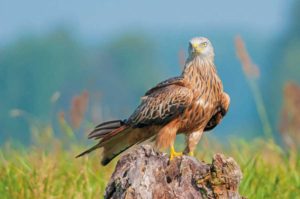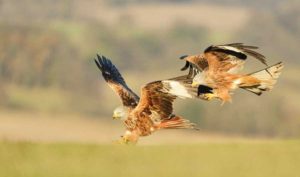See the published version here DECLINE SUCCESS PLIGHT RED KITE
Red Kite – Yorkshire Reporter
It is now quite common to see the majestic Red Kite soaring through the skies of Yorkshire. It is truly fantastic to see these magnificent birds of prey over our towns and countryside as they had been extinct in England and Scotland up until re-introduction to parts of the UK in the late 1980’s. Here, we take a look at these stunning birds, their journey back to the UK, and how they are still facing some problems today.Several hundred years ago, Red Kites were commonplace in much of Britain. They were found in rural areas as well as around human settlements where they fed on the waste of villages and towns. This meant that they were protected by a Royal Charter in the 15th Century, but with the improvements in hygiene over the years their food supply decreased. They also became increasingly persecuted -as the human population grew they were seen as a threat to food supplies. All this combined with popular game shooting led to the birds becoming extinct in England and Scotland around 200 years ago. Some pairs did however manage to survive in Wales.
In 1989 a programme of reintroduction was started to return Red Kites to England and Scotland. Although the birds had been protected in Wales, the population was only growing slowly and it was estimated to be a very long time before they naturally began to recolonise areas outside of Wales. As part of the reintroduction programme, over 90 young birds were released on the Black Isle near Inverness, and in the Chilterns in Oxfordshire and Buckinghamshire over several years. The birds released in England were taken from wild nests in Spain at around 4-5 weeks old and released at around 8 weeks old. The Red Kites released in Scotland were sourced from Scandinavia. All the young birds were fed on a similar diet to what their parents would have fed them in the wild. These initial projects were incredibly successful so this led to reintroductions being planned in other areas too. Yorkshire was the fifth area in the programme and the birds were first introduced to the area on the Harewood Estate in 1999. The success of the Chilterns programme meant that they were able to supply 68 young birds for release in Yorkshire up until 2003.
All the released birds were fitted with wing tags and radio transmitters so that their progress could be monitored, and also so that they could be identified should they be injured or found dead. Yorkshire birds were tagged up until 2006 and have an orange tag. The tags have revealed the fact that some birds released in Yorkshire or reared here have settled in other places such as Northamptonshire and Perthshire, as well as birds from other areas breeding here in our county. The radio transmitters have also been useful in monitoring the behaviour of the Red Kites as they sense their pulse rate. A slow pulse indicates the bird is perched, while a faster pulse shows it is either flying or feeding.
So what do Red Kites like to eat? Their diet is mainly made up of carrion which they will swoop down to snatch up and take to a tree to eat. They do not generally like to land to eat, and will only do so reluctantly if the food is too large to carry off. Unlike other birds of prey, the Red Kite does not have the strength or power to rely on its hunting skills for survival, although they will occasionally catch small live animals such as mice and voles. While Red Kites may occasionally visit gardens, it is not recommended that you feed them as feeding inappropriate food can lead to deficiencies in the diet. It is also the aim of the reintroduction programme that a fully wild population is established who can source their own meals.

Red Kite – Yorkshire Reporter
Red Kites tend to nest in trees, sometimes adding to old crows’ nests or squirrel dreys. They are renowned for decorating their untidy looking nests with strange items – the first successful nest in Yorkshire came complete with a teddy bear’s head and a tea towel! Funnily, in 2006 a nest was discovered an hour before the World Cup match between England and Paraguay with a St George’s flag inside – what a patriotic pair! The downside to collecting such strange items is that they can sometimes waterlog their own nests by lining it with plastic and polythene which leads to the loss of eggs or young chicks. When breeding, Red Kites usually lay 2-3 eggs. The birds released in Yorkshire have been very successful in breeding, and their geographical spread is increasing too.
Unfortunately, it is not all good news for these gorgeous creatures. Red Kites are legally protected and it is an offence to intentionally kill or injure them, take or damage their eggs or nests, and during breeding season it is also an offence to intentionally or recklessly disturb kites at or near their nests. If convicted for any of these offences you can be fined up to £5000 per bird or egg, or even imprisoned for up to six months. Despite these stringent laws, the kites are falling foul of poisons and other problems. Due to their scavenging nature, the birds may be poisoned by illegal baits – a dead rabbit or pheasant that has been treated with a poison to target crows or foxes for example. Such baits have been illegal for over 100 years due to their indiscriminate nature. Another big problem for the kites is the widespread use of rat poison. Since 1999, eight Red Kites are known to have died by consuming poisoned rats, including two chicks who had sadly been fed the poisoned meat by their parents.
Probably the saddest thing of all, is the fact that some birds have been killed after being deliberately targeted. It is hard to understand why anyone would want to harm these beautiful birds but unfortunately Yorkshire kites are known to have died after being shot, and several more injured. Their slow, soaring flight makes them easy targets for immoral gunmen. In March this year, an adult female was found with shotgun wounds just north of Malton. The bird was treated at a specialist rescue centre before being released back into the wild. Also recently another kite was found with shotgun wounds near Harrogate, this means a total of five kites have now been shot in Yorkshire. This time sadly the bird was so injured that it had to be euthanised. Howard Jones from the RSPB’s Investigations team, said: “The reintroduction of Red Kites back into Yorkshire has been a brilliant success, with the birds spread across Yorkshire. However, illegal persecution continues to prevent the species from expanding into some parts of the county. Since the start of the reintroduction, over 20 Red Kites have been killed through illegal poisoning. The recent shootings of red kites continues to show that some people do not want the species to succeed and we urge any anyone with information in connection with these incidents to contact the police.”
There is advice available for if you come across an injured or dead Red Kite;
• Do not put yourself in any danger and do not touch the bird unless absolutely necessary. Be aware that there may be the presence of poison.
• Take photographs of the scene and make notes of anything untoward, but do not disturb potential evidence as it may be the scene of a crime.
• If the bird is alive, contact the RSPCA on 0300 1234 999 or take the bird to the nearest vets if feasible but do not handle it with bare hands.
• If shooting or poisoning is suspected, contact the police immediately on 101 and ask to speak urgently to a Wildlife Crime Officer. Ask for an incident number.
• Further advice can also be sought from the RSPB on 01767 680551 during office hours or 078595 654947 at other times.
Hopefully, despite these horrific crimes and the accidental poisoning of Red Kites, the breed will continue to flourish and live the life they deserve here in Yorkshire and the rest of Britain, with the majority of us looking on in awe at these magnificent birds.








